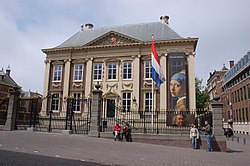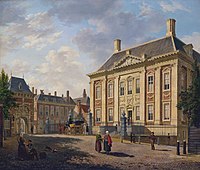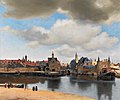 | |
 Mauritshuis in 2005 Mauritshuis in 2005 | |
 | |
| Established | 1822 |
|---|---|
| Location | Plein 29 The Hague, Netherlands |
| Coordinates | 52°04′49″N 4°18′51″E / 52.0804°N 4.3143°E / 52.0804; 4.3143 |
| Type | Art museum |
| Collection size | 854 objects |
| Visitors | 416,334 (2018) |
| Director | Martine Gosselink |
| President | Ila Kasem |
| Owner | Dutch state |
| Website | www |
The Mauritshuis (Dutch pronunciation: [ˈmʌurɪtsˌɦœys], The Hague dialect: [ˈmɑːʁɪtsˌɦœːs]; lit. 'Maurice House') is an art museum in The Hague, Netherlands. The museum houses the Royal Cabinet of Paintings which consists of 854 objects, mostly Dutch Golden Age paintings. The collection contains works by Johannes Vermeer, Rembrandt van Rijn, Jan Steen, Paulus Potter, Frans Hals, Jacob van Ruisdael, Hans Holbein the Younger, and others. Originally, the 17th-century building was the residence of Count John Maurice of Nassau. The building is now the property of the government of the Netherlands and is listed in the top 100 Dutch heritage sites.
History

In 1631, John Maurice, Prince of Nassau-Siegen, a cousin of Stadtholder Frederick Henry, bought a plot bordering the Binnenhof and the adjacent Hofvijver pond in The Hague, at that time the political centre of the Dutch Republic. Between 1636 and 1641, the Mauritshuis was built on this piece of land, during John Maurice's governorship of Dutch Brazil. It was built in the Dutch Classicist style by the Dutch architects Jacob van Campen and Pieter Post. The two-storey building is strictly symmetrical; originally the interior contained four apartments and a great hall. Each apartment was designed with an antechamber, a chamber, a cabinet, and a cloakroom. The building had a cupola, which was destroyed in a fire in 1704.
After the death of Prince John Maurice in 1679, the house was owned by the Maes family, who leased the house to the Dutch government. In 1704, most of the interior of the Mauritshuis was destroyed by fire. The building was restored between 1708 and 1718.
In 1774, an art gallery open to the public was formed in what is now the Prince William V Gallery. That collection was seized by the French in 1795 and only partially recovered in 1808. The small gallery space soon proved to be too small, however, and in 1820, the Mauritshuis was bought by the Dutch state for the purpose of housing the Royal Cabinet of Paintings. In 1822, the Mauritshuis was opened to the public and housed the Royal Cabinet of Paintings and the Royal Cabinet of Rarities. In 1875, the entire museum became available for paintings.
In 1995, the Mauritshuis was established as a non-profit foundation. The foundation set up at that time took charge of both the building and the collection, which it was given on long-term loan. This building, which is the property of the state, continues to be rented by the museum. In 2007, the museum announced its desire to expand. Within three years the definitive design was presented. The museum would occupy a part of the nearby Sociëteit de Witte building. The two buildings would be connected via a tunnel, running underneath the Korte Vijverberg.
The renovation started in 2012 and finished in 2014. The design was by Hans van Heeswijk. During the renovation, about 100 of the museum's paintings were displayed in The Hague's Kunstmuseum in the Highlights Mauritshuis exhibition. About 50 other paintings, including the Girl With the Pearl Earring, went on loan to exhibitions in the United States and Japan. The expanded museum was reopened on 27 June 2014 by King Willem-Alexander.
Controversy over the colonial past of Prince Maurice

In 1664 Prince John Maurice ordered a marble bust portrait of himself for the garden of the Mauritshuis, the Prince's residence in the Hague. The statue was sculpted by the Flemish sculptor Bartholomeus Eggers. Prince Maurice had the bust moved to the burial chamber (Fürstengruft) in Siegen which he had built for himself in 1670.
In 1986 a copy of the statue made in plastic was placed inside the Mauritshuis. The bust was removed from the Mauritshuis in 2017 amidst controversy over Holland's colonial history and Prince John Maurice's role in the slave trade. The Mauritshuis museum has denied that the removal had anything to do with the controversy and has stated that the decision was taken on the grounds that the object was solely a copy made of plastic and the museum was unable to offer the necessary historical context for it in the foyer of the Mauritshuis where it was exhibited. The museum has since created a webpage dedicated to explaining the role of the Prince in the creation of the museum's building and collection and the museum's current view of the Prince. The statements on the page highlight the key role the Prince played in the slave trade in Brazil and how his immense wealth was likely sourced (in certain cases even in breach of then existing rules) from his involvement in the slave trade.
Collection
Further information: List of artists in the collection of the MauritshuisThe collection of paintings of stadholder William V, Prince of Orange was presented to the Dutch state by his son, King William I. This collection formed the basis of the Royal Cabinet of Paintings of around 200 paintings. The collection is currently called the Royal Picture Gallery. The current collection consists of almost 800 paintings and focusses on Dutch and Flemish artists, such as Pieter Brueghel, Paulus Potter, Peter Paul Rubens, Rembrandt van Rijn, Jacob van Ruisdael, Johannes Vermeer, and Rogier van der Weyden. There are also works of Hans Holbein in the collection in the Mauritshuis.
Selected exhibits
-
 Jan de Baen
Jan de Baen
Prince John Maurice (c. 1669) -
 Johannes Vermeer
Johannes Vermeer
Girl with a Pearl Earring (c. 1665) -
 Rembrandt van Rijn
Rembrandt van Rijn
The Anatomy Lesson of Dr. Nicolaes Tulp (c. 1632) -
 Johannes Vermeer
Johannes Vermeer
View of Delft (c. 1660) -
 Paulus Potter
Paulus Potter
The Young Bull (1647) -
 Frans Hals
Frans Hals
Laughing Boy (c. 1625) -
 Rembrandt van Rijn
Rembrandt van Rijn
Self-portrait (1669) -
 Jan Baptist Xavery
Jan Baptist Xavery
Bust of William IV, Prince of Orange (1733) -
 Peter Paul Rubens
Peter Paul Rubens
Night scene (c. 1616/17) -
 Hendrick Avercamp
Hendrick Avercamp
On the ice (c. 1610) -
 Anthony van Dyck
Anthony van Dyck
Portrait of Quintijn Symons (c. 1634) -
 Carel Fabritius
Carel Fabritius
The Goldfinch (1654) -
 Joachim Beuckelaer
Joachim Beuckelaer
Kitchen scene with Christ and the disciples at Emmaus (c. 1563) -
 Jacob van Ruisdael
Jacob van Ruisdael
View of the Dam and Damrak at Amsterdam (1670s) -
 Meindert Hobbema
Meindert Hobbema
Wooded Landscape with Farmsteads (c. 1665)
Administration

The Mauritshuis was a state museum until 1995, when it became an independent foundation. It still continues to receive funding from the Dutch central government. For its estimated budget for 2024, the government provided just under a third (5m Euros) of its total budget of 16m Euros. The Prince William V Gallery is also managed by the organisation.
The museum has a staff of around 91 people. Emilie Elise Saskia Gordenker was museum director from 2008 until 2020. Martine Gosselink assumed the directorship in February 2020. Victor Moussault served as deputy director from 2007 until 2016, succeeded by Sander Uitdenbogaard in 2017.
In the period 2005 to 2011, the Mauritshuis saw between 205,000 and 262,000 visitors per year. In 2011, the museum was the 13th most visited museum in the Netherlands. In 2012, when the museum closed for renovation on 1 April, it received 45,981 visitors. The museum was closed all of 2013 and was reopened on 27 June 2014. It closed for three months in the spring of 2020 in response to the Covid epidemic.
Visitors
| Year | Visitors | Year | Visitors | Year | Visitors | Year | Visitors | |||
|---|---|---|---|---|---|---|---|---|---|---|
| 2005 | 222,477 (est.) | 2010 | 231,795 | 2015 | 500.476 | 2020 | 138.916 | |||
| 2006 | 244,610 (est.) | 2011 | 261,127 | 2016 | 414.239 | 2021 | 113.000 (est) | |||
| 2007 | 230,000 (est.) | 2012 | 45,981 | 2017 | 417.227 | 2022 | 400.000 (est) | |||
| 2008 | 240,000 (est.) | 2013 | closed | 2018 | 416.334 | 2023 | 451.000 (est) | |||
| 2009 | 205,678 | 2014 | 322,000 (est.) | 2019 | 481,667 | 2024 | - |
References
- Address and directions Archived 2017-12-12 at the Wayback Machine, Mauritshuis. Retrieved on 16 June 2014.
- ^ "The Mauritshuis is turned into a museum". Mauritshuis. Archived from the original on August 23, 2006. Retrieved 2008-08-08.
- Search the collection Archived 2017-09-05 at the Wayback Machine, Mauritshuis. Retrieved on 2 August 2019.
- ^ Mauritshuis Museum: Annual Report 2018 Archived 2019-07-11 at the Wayback Machine. Retrieved on 2 August 2019.
- ^ Who we are
- "Location and garden". Mauritshuis. Archived from the original on March 6, 2007. Retrieved 2008-08-08.
- "The building". Mauritshuis. Archived from the original on June 18, 2008. Retrieved 2008-08-08.
- "The 17th-century interior". Mauritshuis. Archived from the original on July 19, 2011. Retrieved 2008-08-08.
- "Fire and restoration". Mauritshuis. Archived from the original on July 19, 2011. Retrieved 2008-08-08.
- "The Mauritshuis is turned into a museum". Mauritshuis. Archived from the original on July 19, 2011. Retrieved 2008-08-08.
- "Mauritshuis presenteert voorlopig ontwerp". Architectuur.org (in Dutch). 22 June 2010. Archived from the original on 29 November 2020. Retrieved 30 December 2013.
- "Mauritshuis aast op De Witte" (PDF). Den Haag Centraal. 3 August 2007. Archived from the original (PDF) on July 31, 2013.
- "Mauritshuis vanaf morgen voor twee jaar gesloten". Trouw (in Dutch). April 2012. Archived from the original on 30 December 2013. Retrieved 30 December 2013.; "Mauritshuis wordt nooit een hal". De Volkskrant. 23 June 2010. Archived from the original on June 26, 2010. Retrieved 30 December 2013.
- architecten, Hans van Heeswijk. "Mauritshuis". www.heeswijk.nl (in Dutch). Retrieved 2024-10-16.
- "Highlights Mauritshuis". Gemeentemuseum. Archived from the original on 8 November 2016. Retrieved 30 December 2013.
- ^ (in Dutch) Nando Kasteleijn, "Het Mauritshuis is weer open. Dit moet je weten over het vernieuwde museum Archived 2015-10-16 at the Wayback Machine", NRC Handelsblad, 2014. Retrieved on 28 June 2014.
- Susie Protschky, Between corporate and familial responsibility: Johan Maurits van Nassau-Siegen and masculine governance in Europe and the Dutch colonial world, in: Susan Broomhall and Jacqueline van Gent (eds), 'Governing Masculinities: Regulating Selves and Others in the Early Modern Period', Aldershot: Ashgate, 2011, p. 162
- Vincent van Velsen, The Mauritshuis Bust and the Volatile Heritage Debate in the Netherlands Archived 2021-04-24 at the Wayback Machine, in Frieze, 5 February 2018
- ‘’Bust Johan Maurits’’ Archived 2020-08-09 at the Wayback Machine, published on 15 January 2018, at the Mauritshuis website
- "Page on Johan Maurits at the Mauritshuis website". Archived from the original on 2021-06-06. Retrieved 2021-06-06.
- "History of the collection". Mauritshuis. Archived from the original on June 18, 2008. Retrieved 2008-08-08.
- "Prince Willem V". Mauritshuis. Archived from the original on July 19, 2011. Retrieved 2008-08-08.; "Royal acquisitions". Mauritshuis. Archived from the original on July 19, 2011. Retrieved 2008-08-08.; "Acquisitions policy". Mauritshuis. Archived from the original on July 19, 2011. Retrieved 2008-08-08.
- ^ "Jaarverslag 2023" (PDF). Retrieved 16 October 2024.
- "Martine Gosselink new director Mauritshuis | Mauritshuis". www.mauritshuis.nl. Retrieved 2024-10-16.
- "Deputy Director Mauritshuis Announces Departure | Mauritshuis". www.mauritshuis.nl. Retrieved 2023-02-15.
- ^ (in Dutch) Top 55 Museumbezoek 2010 Archived 2016-03-04 at the Wayback Machine, Museumvereniging. Retrieved on 21 June 2014.
- ^ (in Dutch) Musea, erfgoed Archived 2020-05-28 at the Wayback Machine, Municipality of The Hague. Retrieved on 21 June 2014.
- ^ Annual Report 2011 Archived 2016-03-04 at the Wayback Machine, Mauritshuis. Retrieved on 21 June 2014.
- (in Dutch) Top 55 Museumbezoek 2011 Archived 2013-09-22 at the Wayback Machine, Museumvereniging. Retrieved on 21 June 2014.
- ^ Annual Report 2012 Archived 2016-03-04 at the Wayback Machine, Mauritshuis. Retrieved on 21 June 2014.
- ^ Mauritshuis Opening on 27 June 2014 Archived 22 October 2016 at the Wayback Machine (press release), Mauritshuis, 2013. Retrieved on 21 June 2014.
- "Mauritshuis Annual Report 2020" (PDF). Mauritshuis. p. 13.
- Mauritshuis Museum: Annual Report 2015 Archived 2022-06-09 at the Wayback Machine.
- "Mauritshuis Jaarverslag 2020" (PDF). Retrieved 20 October 2024.
- Mauritshuis Museum: Annual Report 2016 Archived 2019-08-02 at the Wayback Machine.
- "Mauritshuis Jaarverslag 2021" (PDF). Retrieved 20 October 2024.
- Mauritshuis Museum: Annual Report 2017 Archived 2019-08-02 at the Wayback Machine.
- "Mauritishuis Jaarverslag 2022" (PDF). Retrieved 20 October 2024.
- "Mauritishuis Jaarverslag 2023" (PDF). Retrieved 20 October 2024.
- Successful inaugural year for Mauritshuis Archived 2017-12-12 at the Wayback Machine (press release), Mauritshuis, 2014. Retrieved on 23 June 2015.
External links
 Media related to Mauritshuis at Wikimedia Commons
Media related to Mauritshuis at Wikimedia Commons- Official website
- Mauritshuis
- 1822 establishments in the Netherlands
- Art museums and galleries in the Netherlands
- Art museums and galleries established in 1822
- Buildings of the Dutch Golden Age
- Houses completed in 1641
- Houses in the Netherlands
- Museums in The Hague
- National museums of the Netherlands
- Neoclassical architecture in the Netherlands
- Palaces in the Netherlands
- Royal residences in the Netherlands
- Baroque palaces in the Netherlands
- 19th-century architecture in the Netherlands
- Baroque architecture in the Netherlands